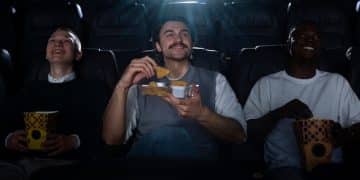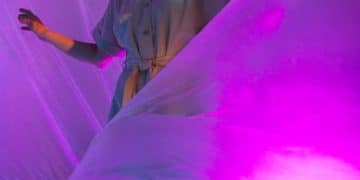Identify and Appreciate Cinematography Techniques in Film
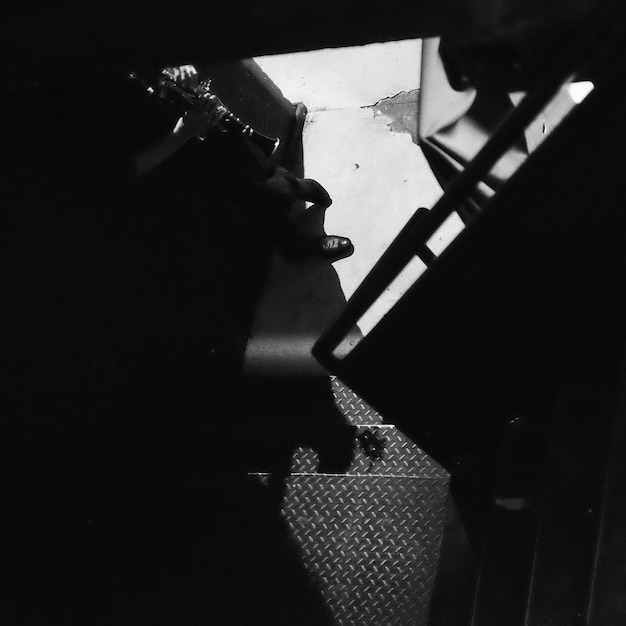
Identifying and appreciating cinematography techniques in film involves understanding how elements like camera movement, lighting, composition, and color contribute to storytelling and evoke specific emotions, enhancing the viewer’s experience.
Do you ever watch a movie and feel captivated by its look and feel, without quite knowing why? The magic often lies in the cinematography, the art of visual storytelling in film. This guide will help you how to identify and appreciate cinematography techniques in film, enhancing your movie-watching experience.
Understanding the Basics of Cinematography
Cinematography is more than just pointing a camera and shooting. It’s a complex art form that involves numerous techniques to create a specific visual aesthetic and communicate a director’s vision. Understanding the foundational elements is the first step in appreciating the craft.
The Role of the Cinematographer
The cinematographer, also known as the Director of Photography (DP), is responsible for the artistic and technical aspects of the visual elements in a film. Their role is to collaborate closely with the director to bring the story to life through imagery.
Key Elements of Cinematography
Several key elements contribute to the overall look and feel of a film. These include camera angles, camera movement, lighting, composition, and color palettes. Each of these elements can be manipulated to create specific effects and convey different emotions.
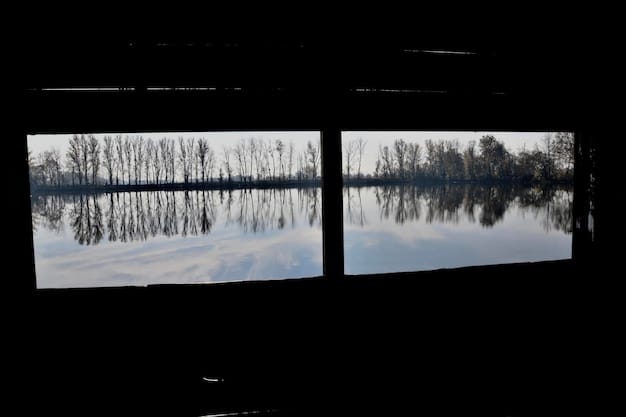
- Camera Angles: The angle at which the camera is positioned relative to the subject can drastically alter the viewer’s perception.
- Camera Movement: Techniques like panning, tilting, and tracking can guide the viewer’s eye and add dynamism to a scene.
- Lighting: The use of light and shadow is crucial for creating mood and atmosphere.
- Composition: The arrangement of visual elements within the frame can create balance, tension, or harmony.
These foundational elements serve as the building blocks upon which cinematographers craft visually compelling stories. Learning to recognize and understand them will deepen your appreciation for the artistry involved.
Camera Angles: Perspective and Meaning
Camera angles can significantly impact how the audience perceives a character or a scene. Different angles create different emotional responses and can reveal or conceal information. Mastering the understanding of these angles is essential to appreciating film.
High Angle
A high angle shot is when the camera is positioned above the subject, looking down. This angle can make the subject appear smaller, weaker, or more vulnerable. It can also create a sense of overview or detachment.
Low Angle
Conversely, a low angle shot is when the camera is positioned below the subject, looking up. This angle can make the subject appear larger, more powerful, or more imposing. It can also evoke a sense of awe or intimidation.
Eye-Level Angle
An eye-level angle is when the camera is positioned at the same level as the subject’s eyes. This angle is the most common. It creates a sense of neutrality and relatability, allowing the audience to connect with the subject on a human level.
Dutch Angle (Oblique Angle)
The Dutch angle, also known as an oblique angle, involves tilting the camera to one side. This angle can create a sense of unease, disorientation, or instability. It is often used in thrillers or horror movies to heighten tension.
Over-the-Shoulder Shot
This shot is framed from behind a person who is looking at the subject. It is used to show the perspective of the character. This is common in dialogue scenes.
Understanding these common camera angles will enable you to analyze how a director and cinematographer use perspective to manipulate the audience’s emotions and understanding of the narrative.
Camera Movement: Adding Dynamism to a Scene
Camera movement is another powerful tool that cinematographers use to engage the audience and guide their attention within a scene. Dynamic camera movements can add energy, create suspense, or reveal new information.
Pan
A pan is a horizontal movement of the camera while it remains fixed on a tripod. It’s often used to follow a moving subject or to reveal a wide landscape.
Tilt
A tilt is a vertical movement of the camera while it remains fixed on a tripod. It can be used to emphasize the height of a subject or to follow a character moving up or down.
Zoom
A zoom involves changing the focal length of the lens to make the subject appear closer or farther away. A zoom can be used to direct the audience’s attention to a specific detail or to create a sense of urgency.
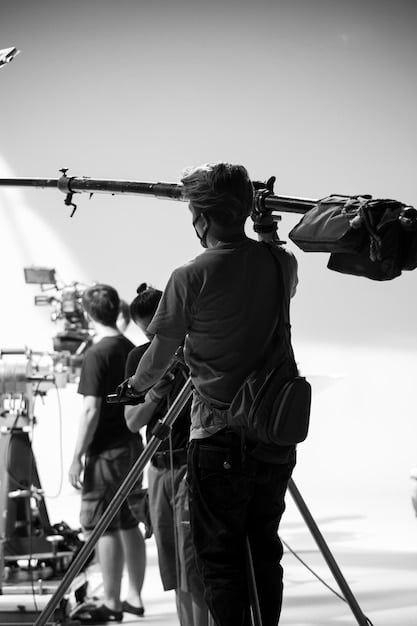
- Tracking Shot (Dolly Shot): A tracking shot involves moving the entire camera along a track or dolly. This allows for smooth, fluid movement alongside the subject, often used to follow a character in motion or reveal a setting.
- Crane Shot: A crane shot involves mounting the camera on a crane, allowing it to move vertically and horizontally. This provides a dynamic perspective and can create sweeping, dramatic visuals.
- Steadicam Shot: A Steadicam is a camera stabilization system that allows for smooth, handheld camera movement. It is often used to follow characters through complex environments while maintaining a sense of fluidity.
Each of these camera movements serves a unique purpose in visual storytelling, adding depth and dynamism to the cinematic experience. Recognizing these techniques will further enrich your film appreciation.
Lighting Techniques: Setting the Mood
Lighting is a crucial aspect of cinematography that significantly influences the mood and atmosphere of a scene. The way light and shadow are used can evoke a wide range of emotions and guide the viewer’s attention.
High-Key Lighting
High-key lighting involves bright, even illumination with minimal shadows. This technique is often used in comedies or musicals to create a cheerful, optimistic atmosphere.
Low-Key Lighting
Low-key lighting, in contrast, involves strong shadows and high contrast. This is often used in thrillers, horror movies, or film noir to create a sense of mystery, suspense, or danger.
Three-Point Lighting
Three-point lighting is a standard technique that uses three light sources: the key light (main light source), the fill light (softens shadows), and the back light (separates the subject from the background).
Chiaroscuro
Chiaroscuro is the use of strong contrasts between light and dark, typically used to create dramatic effects. Drawing from the Italian artistic term, this technique enhances the mood and highlights key elements on the screen.
Lighting is not just about illumination; it’s a powerful storytelling tool that creates depth, emphasizes emotions, and guides the audience’s focus, making it an indispensable element of cinematography.
Composition: Framing the Story
Composition refers to the arrangement of visual elements within the frame. A well-composed shot can create balance, harmony, tension, or visual interest. It’s a silent language telling the story alongside the dialogue.
Rule of Thirds
The rule of thirds involves dividing the frame into nine equal parts using two horizontal and two vertical lines. Placing key elements along these lines or at their intersections can create a more balanced and visually appealing composition.
Leading Lines
Leading lines are lines within the frame that draw the viewer’s eye to a specific point of interest. These lines can be literal (e.g., a road) or implied (e.g., a row of objects). They create depth and guide the viewer’s perspective.
Symmetry and Balance
Symmetrical compositions create a sense of order and stability, while asymmetrical compositions can create tension or visual interest. Balancing elements within the frame is key to creating a visually pleasing image.
Use of Negative Space
Negative space refers to the empty areas around the subject. It can be used to create a sense of isolation, freedom, or anticipation. Proper use of negative space enhances the impact of the main subject.
Understanding compositional techniques allows viewers to appreciate how cinematographers craft each shot to enhance visual storytelling, guide the eye, and elicit emotional responses.
Color Palettes: Evoking Emotion Through Hue
Color is an often-overlooked aspect of cinematography that can profoundly impact the mood and emotional tone of a film. The deliberate use of color palettes can enhance storytelling and evoke specific feelings in the audience.
Monochromatic
A monochromatic color palette uses different shades and tones of a single color. This can create a sense of unity, simplicity, or even melancholy.
Complementary Colors
Complementary colors are colors that are opposite each other on the color wheel (e.g., red and green, blue and orange). When used together, they can create a sense of vibrancy and visual contrast.
Analogous Colors
Analogous colors are colors that are next to each other on the color wheel (e.g., blue, blue-green, and green). Using this palette creates a sense of harmony and tranquility.
Color Symbolism
Colors often carry symbolic meanings that can be used to enhance storytelling. For example, red might symbolize passion or danger, while blue might symbolize calmness or sadness.
By understanding how color palettes are used in film, viewers can gain a deeper appreciation for the visual language of cinema and how it impacts their emotional experience. Recognizing the thought and artistry behind color choices enhances film appreciation.
| Key Element | Brief Description |
|---|---|
| 🎥 Camera Angles | Perspective from which the camera views the subject, affecting audience perception. |
| 🎬 Camera Movement | Techniques like panning and tracking add dynamism and guide the viewer’s eye. |
| 💡 Lighting | Use of light and shadow to create mood, atmosphere, and highlight elements. |
| 🎨 Color Palettes | Selection of colors to evoke emotions and enhance the narrative. |
Frequently Asked Questions About Cinematography
The cinematographer, or Director of Photography (DP), is responsible for the artistic and technical aspects of visual storytelling in film. They work closely with the director to create the film’s visual style.
Camera angles affect how the audience perceives characters and scenes. High angles can make subjects seem vulnerable, while low angles can make them appear powerful, influencing the narrative.
Lighting sets the mood of a scene. High-key lighting creates a bright, positive atmosphere, while low-key lighting creates tension and mystery by emphasizing shadows and contrast.
The rule of thirds divides the frame into nine equal parts. Placing key elements along these lines or intersections creates a balanced and visually appealing composition that guides the viewer’s eye.
Color palettes enhance the film’s emotional tone and storytelling. Monochromatic palettes create unity, while complementary colors create contrast, and each color evokes specific symbolic meanings to enrich the narrative.
Conclusion
By understanding and appreciating these cinematography techniques, you’ll not only enhance your movie-watching experience but also gain a deeper insight into the artistry and technical skill that goes into creating the films we love. From camera angles and movements to lighting, composition, and color palettes, each element plays a crucial role in telling a visual story.

